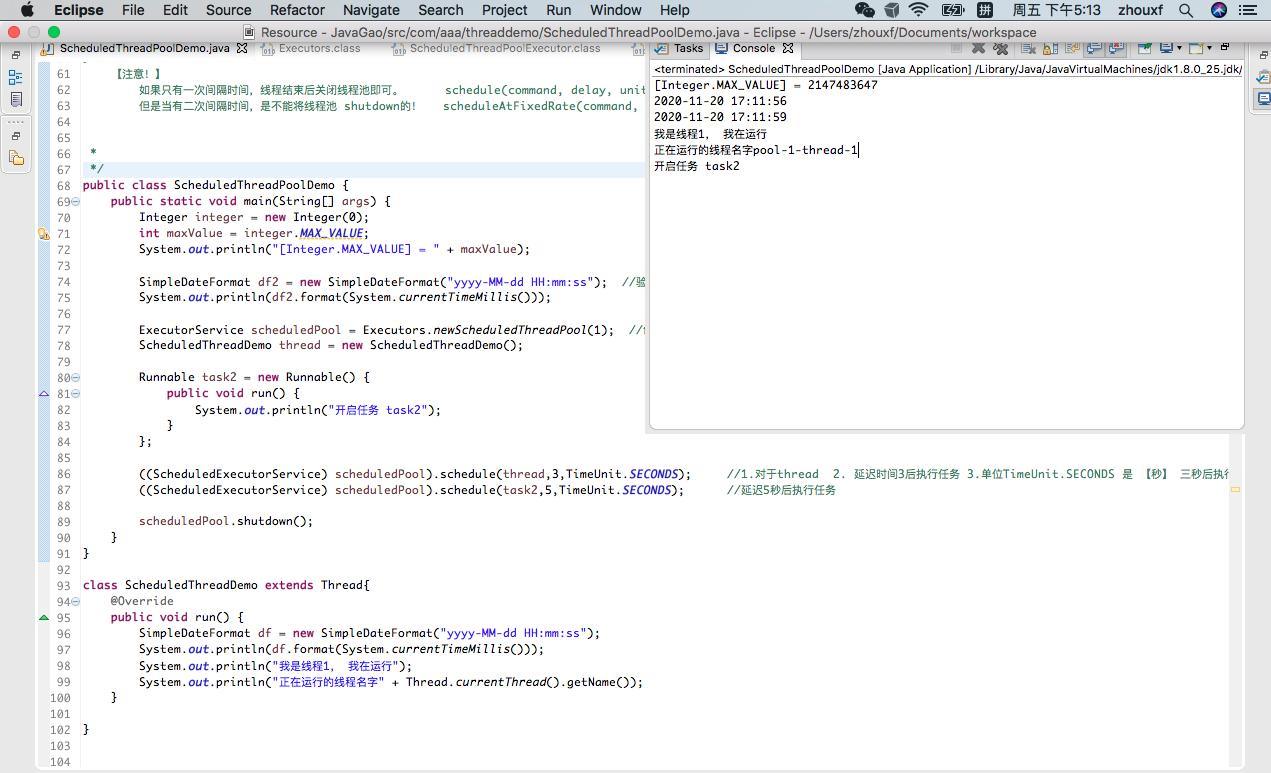常见线程池 newScheduledThreadPool 定时执行任务的线程池 简单介绍
一 定时任务
package com.aaa.threaddemo; import static java.util.concurrent.TimeUnit.NANOSECONDS; import java.text.SimpleDateFormat; import java.util.Date; import java.util.concurrent.ExecutorService; import java.util.concurrent.Executors; import java.util.concurrent.ScheduledExecutorService; import java.util.concurrent.ScheduledFuture; import java.util.concurrent.ScheduledThreadPoolExecutor; import java.util.concurrent.TimeUnit; import javax.xml.crypto.Data; /* * 一 newScheduledThreadPool 是个啥? * 1 是一个线程池 * 2 可定时执行任务 * 3 核心线程数是固定的 * 4 非核心线程数 2147483647 * * public static ScheduledExecutorService newScheduledThreadPool(int corePoolSize) { return new ScheduledThreadPoolExecutor(corePoolSize); } public ScheduledThreadPoolExecutor(int corePoolSize) { super( corePoolSize, Integer.MAX_VALUE, 0, //非核心线程的生存时间是 0 马上回收。 NANOSECONDS, new DelayedWorkQueue()); //一个优先级的队列 阻塞的队列,因为它实现了BlockingQueue } DelayedWorkQueue() 优先级队列怎么用的? 队列一般都是先进先出的,但是在定时/延时任务中,我们需要的是延迟时间短的任务先执行。 为了解决这个问题,需要用到一种特殊的队列 【优先级队列】 对插入的数据进行优先级的排序,保证优先级高的数据先执行。和往队列中插入的顺序无关。 没能深入调查。。。。 二 提供了两个方法可以用 schedule(command, delay, unit) schedule( task, 需要执行的任务 3, 间隔的时间 TimeUnit.SECONDS 时间单位 秒 分 时 。。。 ); scheduleAtFixedRate( command, initialDelay, 初次执行 间隔的时间 period, 再次执行的相隔时间 unit 时间的单位 ) 【注意!】 如果只有一次间隔时间,线程结束后关闭线程池即可。 schedule(command, delay, unit) 但是当有二次间隔时间,是不能将线程池 shutdown的! scheduleAtFixedRate(command, initialDelay, period, unit) * */ public class ScheduledThreadPoolDemo { public static void main(String[] args) { Integer integer = new Integer(0); int maxValue = integer.MAX_VALUE; System.out.println("[Integer.MAX_VALUE] = " + maxValue); SimpleDateFormat df2 = new SimpleDateFormat("yyyy-MM-dd HH:mm:ss"); //验证是否是在三秒后执行 System.out.println(df2.format(System.currentTimeMillis())); ExecutorService scheduledPool = Executors.newScheduledThreadPool(1); //创建定时的线程池 核心数量 2 ScheduledThreadDemo thread = new ScheduledThreadDemo(); Runnable task2 = new Runnable() { public void run() { System.out.println("开启任务 task2"); } }; ((ScheduledExecutorService) scheduledPool).schedule(thread,3,TimeUnit.SECONDS); //1.对于thread 2. 延迟时间3后执行任务 3.单位TimeUnit.SECONDS 是 【秒】 三秒后执行 ((ScheduledExecutorService) scheduledPool).schedule(task2,5,TimeUnit.SECONDS); //延迟5秒后执行任务 scheduledPool.shutdown(); } } class ScheduledThreadDemo extends Thread{ @Override public void run() { SimpleDateFormat df = new SimpleDateFormat("yyyy-MM-dd HH:mm:ss"); System.out.println(df.format(System.currentTimeMillis())); System.out.println("我是线程1, 我在运行"); System.out.println("正在运行的线程名字" + Thread.currentThread().getName()); } }
看结果

二 scheduleAtFixedRate ?
package com.aaa.threaddemo; import static java.util.concurrent.TimeUnit.NANOSECONDS; import java.text.SimpleDateFormat; import java.util.Date; import java.util.concurrent.ExecutorService; import java.util.concurrent.Executors; import java.util.concurrent.ScheduledExecutorService; import java.util.concurrent.ScheduledFuture; import java.util.concurrent.ScheduledThreadPoolExecutor; import java.util.concurrent.TimeUnit; import javax.xml.crypto.Data; /* * 一 newScheduledThreadPool 是个啥? * 1 是一个线程池 * 2 可定时执行任务 * 3 核心线程数是固定的 * 4 非核心线程数 2147483647 * * public static ScheduledExecutorService newScheduledThreadPool(int corePoolSize) { return new ScheduledThreadPoolExecutor(corePoolSize); } public ScheduledThreadPoolExecutor(int corePoolSize) { super( corePoolSize, Integer.MAX_VALUE, 0, //非核心线程的生存时间是 0 马上回收。 NANOSECONDS, new DelayedWorkQueue()); //一个优先级的队列 阻塞的队列,因为它实现了BlockingQueue } DelayedWorkQueue() 优先级队列怎么用的? 队列一般都是先进先出的,但是在定时/延时任务中,我们需要的是延迟时间短的任务先执行。 为了解决这个问题,需要用到一种特殊的队列 【优先级队列】 对插入的数据进行优先级的排序,保证优先级高的数据先执行。和往队列中插入的顺序无关。 没能深入调查。。。。 二 提供了两个方法可以用 schedule(command, delay, unit) schedule( task, 需要执行的任务 3, 间隔的时间 TimeUnit.SECONDS 时间单位 秒 分 时 。。。 ); scheduleAtFixedRate( command, initialDelay, 初次执行 间隔的时间 period, 再次执行的相隔时间 unit 时间的单位 ) 【注意!】 如果只有一次间隔时间,线程结束后关闭线程池即可。 schedule(command, delay, unit) 但是当有二次间隔时间,是不能将线程池 shutdown的! scheduleAtFixedRate(command, initialDelay, period, unit) * */ public class ScheduledThreadPoolDemo { public static void main(String[] args) { SimpleDateFormat df2 = new SimpleDateFormat("yyyy-MM-dd HH:mm:ss"); //验证是否是在三秒后执行 System.out.println(df2.format(System.currentTimeMillis())); ExecutorService scheduledPool = Executors.newScheduledThreadPool(1); //创建定时的线程池 核心数量 2 ScheduledThreadDemo thread = new ScheduledThreadDemo(); Runnable task2 = new Runnable() { public void run() { System.out.println("开启任务 task2"); } }; Runnable task3 = new Runnable() { public void run() { System.out.println("开启任务 task3"); } }; ((ScheduledExecutorService) scheduledPool).schedule(thread,3,TimeUnit.SECONDS); //1.对于thread 2. 延迟时间3后执行任务 3.单位TimeUnit.SECONDS 是 【秒】 三秒后执行 ((ScheduledExecutorService) scheduledPool).schedule(task2,5,TimeUnit.SECONDS); //延迟5秒后执行任务 ((ScheduledExecutorService) scheduledPool).scheduleAtFixedRate(task3, 8, 3, TimeUnit.SECONDS); //对于task3 程序启动 8秒后执行,中间间隔3秒执行一次。 // scheduledPool.shutdown(); } } class ScheduledThreadDemo extends Thread{ @Override public void run() { SimpleDateFormat df = new SimpleDateFormat("yyyy-MM-dd HH:mm:ss"); System.out.println(df.format(System.currentTimeMillis())); System.out.println("我是线程1, 我在运行"); System.out.println("正在运行的线程名字" + Thread.currentThread().getName()); } }
查看结果





 浙公网安备 33010602011771号
浙公网安备 33010602011771号